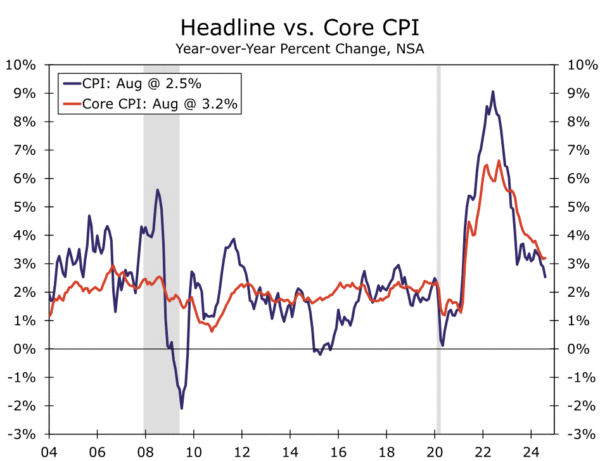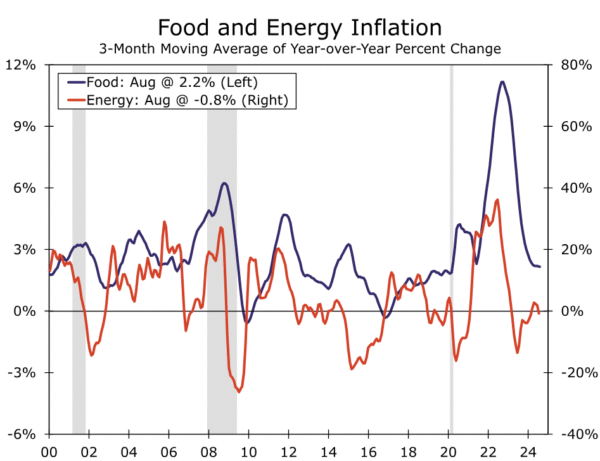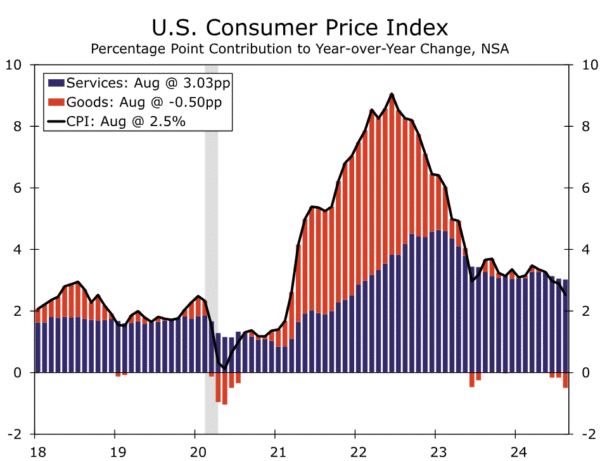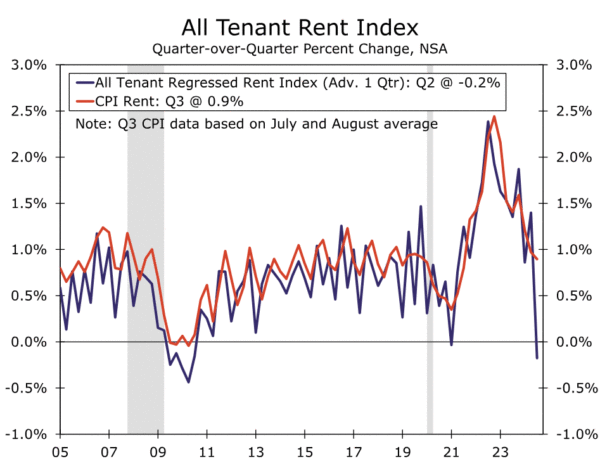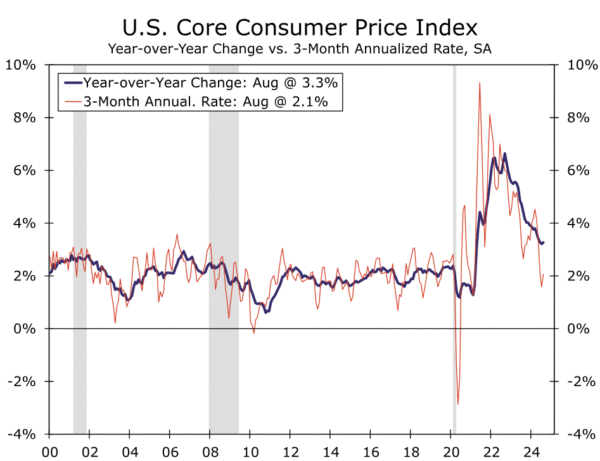Summary
August’s inflation data probably cement a 25 bps, rather than a 50 bps, reduction in the federal funds rate at next week’s FOMC meeting in our view. The 0.2% increase in headline CPI was in line with expectations, while the 0.3% increase in core CPI was slightly higher than consensus forecasts.
Another month of tepid food inflation and falling energy prices kept headline inflation in check. Excluding food and energy, the deflation in core goods remained in effect, led by a 1.0% drop in prices for used autos. A larger-than-expected drop in prices for core goods was more than offset by faster-than-expected services inflation. A bounce back in travel-services prices such as lodging away from home and airfares ended a run of unusually soft readings for these categories. Primary shelter inflation also came in high relative to our expectations and at odds with leading indicators from private sector data sources. Overall, we see the lingering split between goods and services inflation as a sign that the unwinding of pandemic-era effects on prices is taking somewhat longer, rather than as an indication disinflation is running out of steam.
On balance, today’s data suggest that a 25 bps rate cut is more likely than 50 bps next week, but we would not be completely shocked if the FOMC elected to move by 50 bps. Furthermore, starting with a 25 bps move does not rule out a pickup in the pace of policy easing at future meetings. The ongoing deterioration in the labor market has become an increasing focus for the FOMC, and inflation is slowly but surely returning to 2% on trend. The core CPI has increased at a 2.1% annualized pace over the past three months, a slow enough pace that 50 bps rate cuts at future meetings remain squarely on the table if the labor market data spur faster action. Regardless, all signs point to additional rate cuts beyond next week in our view.
Split Between Goods and Services Inflation Was Amplified in August
Inflation in August came in roughly in line with expectations, rising 0.2% in the month and 2.5% over the past year according to the Consumer Price Index. A relatively small 0.8% decline in energy prices in the month helped keep headline inflation in check, led lower by a 0.6% dip in gasoline prices and a 1.9% drop in utility gas service. Based on the limited data available for September and the recent trend in oil prices, another decline in energy prices appears likely to come in next month’s CPI release. Food inflation also continued its run of relatively benign gains, rising 0.1% in August. Price growth for food consumed away from home (0.3% month-over-month and 4.0% year-over-year) once again outpaced inflation at the grocery store (prices unchanged over the month and up 0.9% compared to one year ago).
Monetary policymakers like those at the Federal Reserve tend to focus on inflation excluding food and energy given that these two components are quite volatile and their prices are often determined by factors other than the stance of monetary policy. That said, headline inflation better reflects the price growth that consumers experience in their daily lives. Much slower food and energy inflation over the past year has brought good news for households on the inflation front. The 2.5% increase in the headline CPI over the past 12 months is more or less in line with where this indicator was on the eve of the pandemic (2.3% in February 2020).
Core inflation picked up in August, rising 0.3% after a 0.2% gain in July. The slower pace of disinflation when excluding food and energy comes amid what is still rather sticky services inflation. Core services prices advanced 0.4% in August, the largest increase since April. The moderation in shelter inflation remains painfully slow. Despite the notably lower pace of rental inflation signaled by private sector measures, primary shelter (the weighted average of rent of primary residences and owners’ equivalent rent) rose 0.5% in August. We have not given up the view that shelter inflation should slow more materially ahead, with the BLS’s All Tenant Rent Index having fallen sharply. That said, the stubbornly high pace of official shelter inflation raises some doubts about the extent to which it may ultimately ease further this cycle.
Core services ex-shelter also got a boost in August from higher travel-related prices (lodging away from home +1.8%, airfares +3.9%). Given that these categories are some of the more volatile components of core services, we are less concerned about their monthly rise in the context of further services disinflation ahead. Meanwhile, outright deflation in the goods sector continues. Core goods fell 0.2%, led by a drop in used autos (-1.0%). While auction prices point to a rebound in used vehicle prices over the next month or two, outside the auto space, goods prices also declined in August, signaling the benefits of smoother supply chains and cooler demand have yet to run their course.
While core prices rose more in August relative to the prior three-month average pace of monthly gains (0.13%), the early summer pace likely understated the trend in inflation just as the first quarter’s average gain of 0.37% seemed to overstate it. August’s figures likely give a somewhat cleaner read, in our view. The three-month annualized rate of core CPI inflation was just 2.1% in August, below the year-over-year pace of 3.2%. With food and energy related commodity prices having retreated of late and ongoing cooling in the labor market, we expect inflation to remain in check in the months to come.
The combination of today’s CPI report, last Friday’s employment report and recent communication from key Fed officials leads us to believe that the FOMC will reduce the federal funds rate by 25 bps at its meeting next week. That said, we would not be completely shocked if the FOMC opted for a 50 bps rate cut instead. Nonfarm payroll growth has slowed significantly in recent months, and the upward trend in the unemployment and under-employment rates is concerning. The pickup in core CPI inflation from July to August is unwelcome news for those hoping for a larger cut next week, but the underlying trend in price growth remains down in our view.




